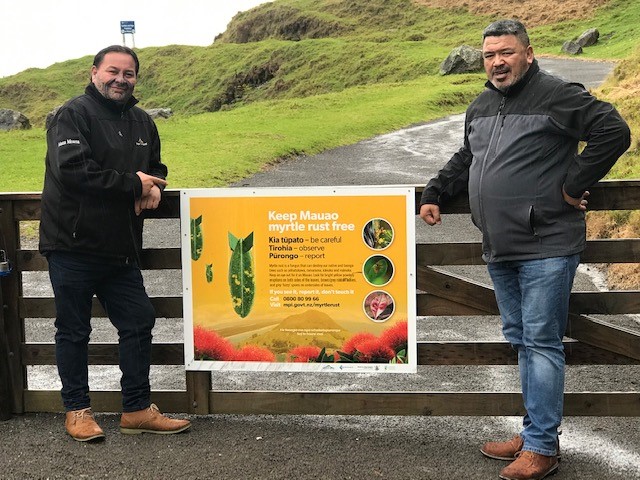Alby Marsh – bringing people together to fight myrtle rust
“There’s a saying in Māoridom,” says Alby Marsh, Māori Relationship Manager at Plant & Food Research (PFR). “Kāore te kūmara e kōrero mō tōna ake reka – the kumara doesn’t talk about how sweet it is. The hardest part for me about interviews like this is talking about myself.”
Alby lets his life’s work speak for him – he has held various roles building relationships between iwi and PFR and also between iwi and other organisations, including Crown Research Institutes. He is currently working with researchers and communities to build relationships and solutions that will help in the fight against myrtle rust.
However, he didn’t start as a relationship manager. As a research technician at PFR (Crop and Food Research during that time), Alby was trained in vegetable pathology. It was in this role that he started contributing to the subject of mātauranga Māori and was able to develop his interest in the contribution Māori can make to identifying potential solutions for plant diseases.
“We’ve become reliant on chemicals in our food production systems,” says Alby, “We’re looking to reintroduce natural methods and traditional knowledge to our production system.”

After nearly a decade as a research technician, Alby became a research associate in 2008. He is now a sought-after expert adept at making connections between Māori and science.
His current roles involve building relationships with Māori to facilitate joint efforts to protect plants against myrtle rust. Alby has been involved in the myrtle rust response since the disease arrived in Kerikeri on mainland New Zealand in 2017. He now helps Beyond Myrtle Rust and BioHeritage develop and maintain relationships with Māori stakeholders. Rather than seeking new relationships, Alby has been focusing on refreshing relationships that were built under the initial response funded by MPI.
“Along with picking up where we left, we’re also trying to introduce new elements to the program,” says Alby.
One of the new elements is the mātauranga element – identifying if there is a local solution to myrtle rust.
“We are evaluating whether traditional practices, techniques or solutions that have been tried on other diseases or pests might have applications for myrtle rust.”
Researchers are currently testing whether native plant extracts have any effect on myrtle rust. They will be checking to see if natural compounds might reduce disease spread or improve defense mechanisms for the plant.
“If the desired effects can be found in the lab, the solutions can be tested in the field,” says Alby.
One method that may be ready for field testing is the application of seawater to the leaves of diseased plants.
“There is a belief by some people that their pōhutukawa is being protected by a film of salt,” says Alby. “Solutions like this may sound basic or simple, but we will only know if there is any validity to these solutions once we test them.”
He is also looking for ways to actively involve the community in monitoring efforts.
“There is nothing worse than Māori, or anyone else on the ground, seeing myrtle rust on a plant and not being able to do anything about it.”
Alby is working with researchers to find ways to involve communities in monitoring groups to systematically record the presence and spread of myrtle rust.
“We want to develop a way for communities to submit information gathered through monitoring efforts to a central reservoir which could help us identify the movement of that disease in their rohe.”
“A priority is research to understand and demonstrate the value of community involvement in science and conservation.
By working together, researchers, agencies and the community stand a better chance of protecting our native myrtles from the threat of disease.
Posted March 2021